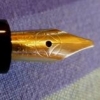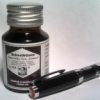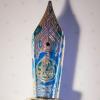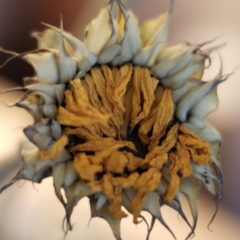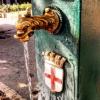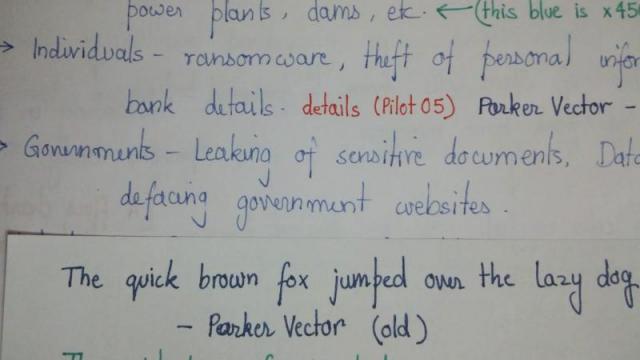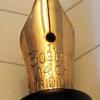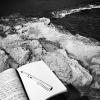Search the Community
Showing results for tags 'fine'.
-
PRELUDE In the search of suitable replacements for a Meisterstuck Doue FP 145 My meticulously planned fountain pen hiatuses are occasionally disrupted by the well-meaning members of my family. Instead of appreciating my carefully timed fountain pen acquisitions, they enthusiastically offer a...
- 21 replies
-
- montblanc
- marc newson
-
(and 3 more)
Tagged with:
-
Greetings All, Pardon the sloppiness (and embarrassing typos everywhere, even the first word ), but I wanted to get out this review as soon as possible because I'm so excited about this pen. I've had a lot of bad luck with Chinese pens (Hero's have been anything but my hero), but so far no Jinh...
-
The Ondoro is another of my Faber-Castell Design (FCD) pens. These FCD steel nibs are common across the entire design product range - Basic, Loom, Ambition, Ondoro & e-motion and have been impeccable in my experience. My first pen from the design series was an Ambition. I feel that the Ondoro is str...
- 32 replies
-
- faber-castell
- ondoro
-
(and 5 more)
Tagged with:
-
I love everything about the Triple Tail. The largeness. The clearness. The non-smellyness. The plunger filling system. The 308 cartridges I can use. Everything, that is, but the nib itself. It's just too darn much for me. It's finicky, which is bad enough. But even when it does work after heat se...
-
desaturated.thumb.gif.5cb70ef1e977aa313d11eea3616aba7d.gif)
Q: I Use Western Fine Nibs. What Is The Japanese Equivalent?
A Smug Dill posted a topic in Of Nibs & Tines
Disclaimer: Not my question personally. I have eleven Plaisir and six Preppy pens – with interchangeable sections and nibs, so for the purposes of how ink flows from the cartridge or converter onto the page to form shaped marks by way of the nib, they are identical (to the DPQ-700A desk pen as... -
I recently acquired two Sheaffer Sagaris fountain pens, one with a fine nib, the other with a medium. I decided that I preferred the fine nib so I went looking for a fine nib unit to purchase to replace the medium. Since it's the entire unit, it should just screw into the barrel, right? I found a...
-
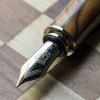
An Intuitive Conversation With The Graf Von Faber-Castell Intuition
sannidh posted a topic in Fountain Pen Reviews
After a long & strong fight with the penavarice-devil , I finally gave in and bought a GvFC Intuition. I went with the 'terra' - the red-orang-ish barrel. I have also replicated the content with some additional pictures in my blog as the images are reduced to a small thumbnail after a short-while...- 41 replies
-
- graf von faber-castell
- intuition
-
(and 8 more)
Tagged with:
-
Periodically I come back to writing with a fountain pen. I cant afford expensive pens but tend to use Fine nibs if available I am old school so big problem is writing checks. Find even fine nibs seem to bleed and form larger lines. Have found it necessary to reverse the n...
- 38 replies
-
- ckeck writing
- reverse
-
(and 2 more)
Tagged with:
-
The lip around the feed holder cracked on my fine nib for my TWSBI mini. Fortunately, I contacted TWSBI and they were able to send me a brand new feed holder, free of charge. Wonderful, exactly what I wanted. When I asked for how to then replace the feed holder, I was told you just had to pull an...
-
First of all I want to mention this review by FPN user sova featuring stunning photos of the Turquoise blue Platinum Procyon. In my opinion the Platinum Procyon receives less attention than it deserves, thus I decided to write a review. I want to provide some information, share my experience using...
-
Can you believe it? I really did not need another pen, but I got one anyway. The Lamy 2000 Fine - Macrolon. It is my 3rd Western fine, vs. the Waterman Carene and Pelikan M120 Iconic Blue. On paper their line output is almost identical. The Pelikan I would consider slightly wet and the Lamy an...
-
Hello again to all my FP-friends, Allow me to introduce to you the Jinhao 992’s oddly named and somewhat homely younger sister—the 991. This pen comes in both an EF (0.38) hooded nib and F open nib version. Since the nib, feed, housing, and converter on the F nib version are identical to that of t...
-
Hi FPN, I have been lurking for quite a while but this is my first post on here. I currently own a TWSBI 580 and a Lamy Safari, both in extra-fine, I have been considering purchasing either an Edison collier or a Pelikan m400 pen. I like my nibs to draw quite thin lines having come from Uni-ball...
-
Hi everyone, I'm talking about the pen, not the plane. Has anyone used one of these?? I handled one in a local shop the other day and have been thinking about it ever since. It has a nice tactile surface, seems well balanced, and looks pretty cool. At least here in China they cost a lot mo...
-
My better half said: "I see that line and I don't want it" Funny English that way but the M605 fine nib wrote out of the box smooth yet more like a fat medium whose line does not pair with its refined looks. Also occasional hard starts, my guess: new pen baby bottoms So I've been thinking abou...
-
In this post I will review the Waterman Expert Deluxe Fountain Pen. The one which I have has a fine nib. Official Product Link of the pen Flipkart Link from where I bought the pen Background: I have been using the Waterman Expert for more than 3 years. It is my second waterman pen. Prior to th...
-

A Tale Of The Lesser Flagship Of Montblanc : The Meisterstück 146
sannidh posted a topic in Fountain Pen Reviews
Loved the MB's flagship pen review by Betweenthelines. And then realized, I was yet to post a review on FPN for the lesser one, the 146. As for me, I came across a real Montblanc pretty much later in life, though used to love a pen called Camlin Premier during school days. It came with a 1-pen le...- 22 replies
-
- montblanc
- meisterstück
-
(and 5 more)
Tagged with:
-
Very Disappointing Experience With A Pelikan M805 Stresemann
John545 posted a topic in Fountain & Dip Pens - First Stop
Hi Guys. I have been into fountain pens for a while now, but I hadn't bought any expensive pens until now. My collection mainly consisted of TWSBIs which I have been very happy with. I worked really hard this year for my 2nd-year exams, and I worked pretty hard over the summer in an internship s... -
Hi guys, I'm strongly considering acquiring the pen in object, but before I pull the trigger I have a doubt that must be dispelled with your help. I am aware of all the issues of the FA nib & feed relative to ink flow and I'm OK with that. I would like to use this pen just to enliven my handwriting,...
-
Save 35% off MSRP on Pelikan Extra-Fine (EF) Nib Fountain Pens in Stock at Paper, Ink Pen with discount code extrafine MSRP Regular Price extrafine PriceStresemann M805: $850.00 $680.00 $550.80 M805 & M800: $760.00 $608.00 $492.48...
-
Hello forum, I bought a Jinhao x450 and I had a query regarding the nib. I thought the pen comes with a Medium nib, but it looks to be much finer. Can you confirm from the images ? Is there something wrong with the nib/flow ? You can see it breaks in the "F" and bottom of "G"s. (please zoom the...
-
There are already a few Supra Brass reviews on FPN, be sure to check those out. At the end of this review I've copied my thoughts (originally from https://www.fountainpennetwork.com/forum/topic/337221-kaweco-sport-10mm-short-of-love/) about often-heard complaints about Kaweco, which I feel are worth...
- 8 replies
-
- kaweco
- supra brass
-
(and 2 more)
Tagged with:
-
Another light review, with a few snaps... Preamble (as usual, skip this bit if you don’t like preambles): We have been incredibly fortunate to be able to get our hands on some pretty nice pens over the last few years. The posting of my last review prompted quite a lengthy conversation between “Sh...
-
Help ! So many different brands and models. Where do I start My Extra Fine Wing Sung 3003 has developed some intermittent feed issues. Have given it a though clean a couple of times without any success. Halfway through a drawing is not the time to be coping with a drying out or extra wet inkfl...
-
Greetings Fellow FPNers, Below are some of my thoughts on the Thyer edition of the Jinhao 911. This review turned out sounding a little more negative than I had intended, but don’t let it scare you away from this pen. Many of the good points about the Jinhao 911 have already been discussed in Ki...


